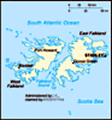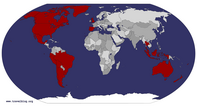Advertisement
Published: January 28th 2015
Monday 26
thJanuary 2015
Note: the last blog had thirty-one photos so went on to two pages. We dropped anchor in the natural harbour of Port William on East Falkland, at 7.30 a.m. this morning. We were tendered ashore to the pier at Stanley, dolphins followed the tenders to and fro all day, and an elderly sea lion was asleep on the pier. We were welcomed with Brit voices saying “Hello, how do you do?” and we felt so at home; it felt good. The Falkland islanders are so patriotic, with Union Jacks flying everywhere; it felt like England in June 2012, for the Diamond Jubilee. In the Falklands, it is like this every day! Even on our cruise ship, the day before as we were heading for the islands, the American Grill Bar became an English pub, serving fish and chips, pies with HP sauce and Union Jack bunting was strewn up as decoration. The American passengers loved it, the Argentinians didn´t seem to complain, and the Brits, fewer in number, rather enjoyed the atmosphere. The Japanese of course, always in fun party mood, love everything novel and different that can be
photographed!
The Falkland Island archipelago is made up of two main islands, East Falkland and West Falkland, together with 776 smaller islands. This remote area of land is home to just over three thousand people and ten times as many penguins! The islands were first discovered by sea Captain, John Davies in 1592 and he is represented on the island´s flag, with the name of his ship “Desire”. They were named as the Samson Islands. The first settlers were Spanish sailors, then some French and Portuguese as well, in the 16
th Century. In the 17
th Century the British arrived and re-named the islands as the Falklands and they have been a British Territory since 1883 (our jeep driver was proud to say that he was a fifth generation Falkland Islander); more of the jeep ride later. Stanley is twinned with Whitby.
The climate of the Falklands has an appalling reputation, especially because it is often impossible to dock there due to high winds (as was the case for us in Ushuaia, Argentina just a few days ago) but we enjoyed a beautiful sunny day with little wind, although it was cold.
The Falklands played a part in World Wars I and II, and war memorials in Stanley reflect this, but the conflict that launched the islands into modern world headlines was the Falkland War in 1982 between Argentina and Great Britain. Beset with domestic problems, the military dictatorship of Argentina decided to divert public attention elsewhere by invading the Falklands. In April 1982 the peaceful little town of Stanley, with just under two thousand people, mostly sheep farmers and fishermen, were invaded and occupied by Argentinian Special Forces. The rest, as they say, is history. British forces liberated the Falklands, the military regime in Argentina collapsed (one positive result of the conflict), and the islanders, who would have lost their homes and way of life, if not their lives, since Argentina planned to turn the islands into a penal colony for all of their political prisoners, regained their way of life and have been waving Union Jacks ever since. Maggie Thatcher, understandably, is the Falkland´s heroine, and a bust of her has recently been installed near to the Liberation Monument. Whatever one´s political leaning, not many people nowadays criticise her decision to send in the troops to liberate the Falklands, although
a heavy price was paid; 255 lost their lives liberating just 3,000, and many more were injured, but they also gave their lives to counter an atrocity: the atrocity of one country´s invasion of another, without a declaration of war.
“They are few in number but they have the right to live in peace, to choose their own way of life and to determine their own allegiance” Margaret Thatcher, 3
rd April 1982
Three civilians also died and their names are inscribed on the Liberation Monument alongside the names of the 88 Royal Navy sailors, 27 Royal Marines, 10 sailors from the Fleet Auxiliary, 6 Merchant seamen, 1 pilot and 123 soldiers who lost their lives. The number of Argentinian loses was much greater but unknown. Many Argentinians, tragically, are still trying to find out what happened to their loved ones. Although the British Government has given permission, the Argentinians have never attempted to try to recover the bodies of those lost. One can still see their fox holes and entrenched positions around Stanley, where the land mines are at long last being cleared. They have been fenced off for thirty two years,
but only now are they being cleared. “Red tape” has hindered this process; the UK are carrying out the work and will be sending Argentina the bill, knowing full well that it probably will never be paid! At the moment, one cannot hike around the Falklands at will, one needs a guide at all times. The Argentinians planted thousands of the nasty things, and unexploded ordinances litter the countryside. Fortunately the areas are well-signposted and fenced off, so there have never been any casualties since 1982.
We got one of the first tenders from the ship at 8 a.m., so we didn´t see the dolphins following in our wake as others still aboard the Golden Princess did. Once ashore we got on a minibus which took us south of Stanley towards Bluff Cove. On the way we passed men clearing land mines. We also passed Tumbledown Ridge, near Mount Challenger. Tumbledown was the scene of one of the fiercest battles of the Falklands War. We also passed other well-known names from the war, namely, Mount Longdon, Wireless Ridge and Mount Kent. We also saw fox holes and Argentinian entrenchment sites, which remain untouched and un-investigated, due to
the mines in the area. One cannot help wondering if Argentinian bodies are still down there. Our driver thought that they probably are. When we came to the end of the road, we changed vehicles, to jeeps, to cover the rough terrain down to the cove. It was only about a twenty minute drive but it was really good, through peat bogs, ditches and water courses.
When we got to Bluff Cove we were greeted by hundreds of penguins and as well as Gentoo Penguins, there were about two dozen King Penguins, the Standard Kings, with orange necks. This was really thrilling, and brings our total number of penguin species seen, to six. Most of the penguins were young juveniles, awaiting their parents who were out at sea harvesting fish. There were also a few babies, being guarded by one parent, whilst the other was off fishing; the mums and dads take it in turn to guard the babies, who are maybe too young to survive, being born so late (most of the youngsters are as big as the adults, just fluffier). There are approximately 1,000 breeding pairs of Gentoos at Bluff Cove, and this summer a
lot of babies have been born. Gentoos are the third largest penguins, after Emperors and Kings, and they do not migrate, they live in Bluff Cove all year, so the population is increasing. The adults are about 60 cms tall and weigh about 6 kilograms. King Penguins are much bigger, about 90 cms tall and weighing approximately 13 kilograms. It was a wonderful experience, seeing so many of these entertaining birds. It was a great morning´s expedition!
In the afternoon, we walked around Stanley, and also got online to publish our previous blog. Stanley is a lovely little town, so clean, neat and tidy, and very British. We visited both the Anglican Cathedral and the Catholic Church, both quite simple and elegant. The Cathedral, called Christ Church Cathedral, has some beautiful stained glass windows. It was built in 1892 and the Catholic Church, St. Mary´s, was built in 1899. Adjacent to the Cathedral is a whale bone arch, erected in 1933 to celebrate the centenary of British administration. The Liberation Monument, was designed by a Falkland Islander, paid for by public subscription and built by volunteer labour. It is adorned with poppy wreaths and is inscribed with
the following words…
“In Memory of those who liberated us” 14 June 1982
The Post Office has two red telephone boxes and a red post box outside; this left us in no doubt as to where we were! In the gift shops they sell British souvenirs. We bought a tea towel with the slogan “Keep calm and keep the Falklands British”. As you do!
We got back to the ship late afternoon and weighed anchor at 7 p.m. As we sailed away from the islands, we were really lucky to see a large school of whales harvesting the sea all along the coast of East Falkland. We saw water spout after water spout, doing our Captain Ahab impersonations, yelling “There she blows!” We didn´t see Moby Dick, but we saw dozens of spouts, and they were from large whales. We were so cold and really shivering, despite wearing gloves, hats and layers of clothing, but it was so worth the discomfort. What a memorable day!
We are now heading towards Puerto Madryn in Argentina, where we shall arrive early on Wednesday morning. It is an area
well-known for sighting whales, dolphins and Orcas, so we might see some more marine wildlife if we are lucky. Who knows? In the meantime we shall have time to chill out and enjoy being on this wonderful ship. Although it is cold weather, the Jacuzzis are always lovely and warm! It´s a hard life really!
Advertisement
Tot: 0.281s; Tpl: 0.013s; cc: 20; qc: 99; dbt: 0.121s; 1; m:domysql w:travelblog (10.17.0.13); sld: 1;
; mem: 1.3mb
























